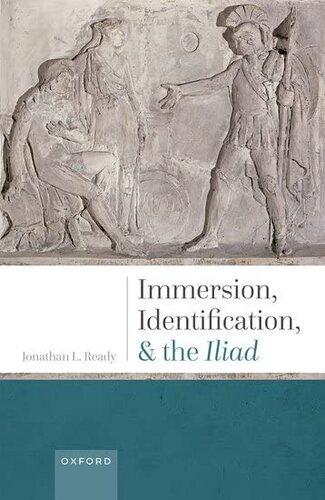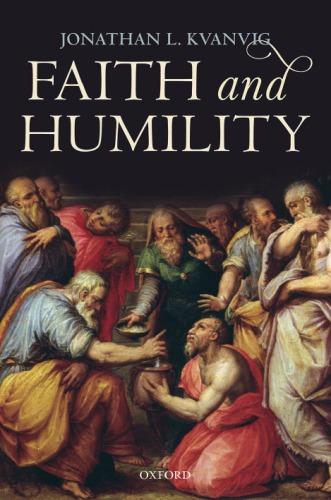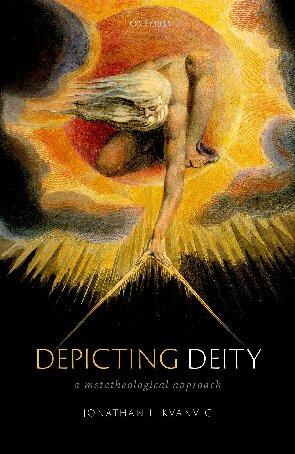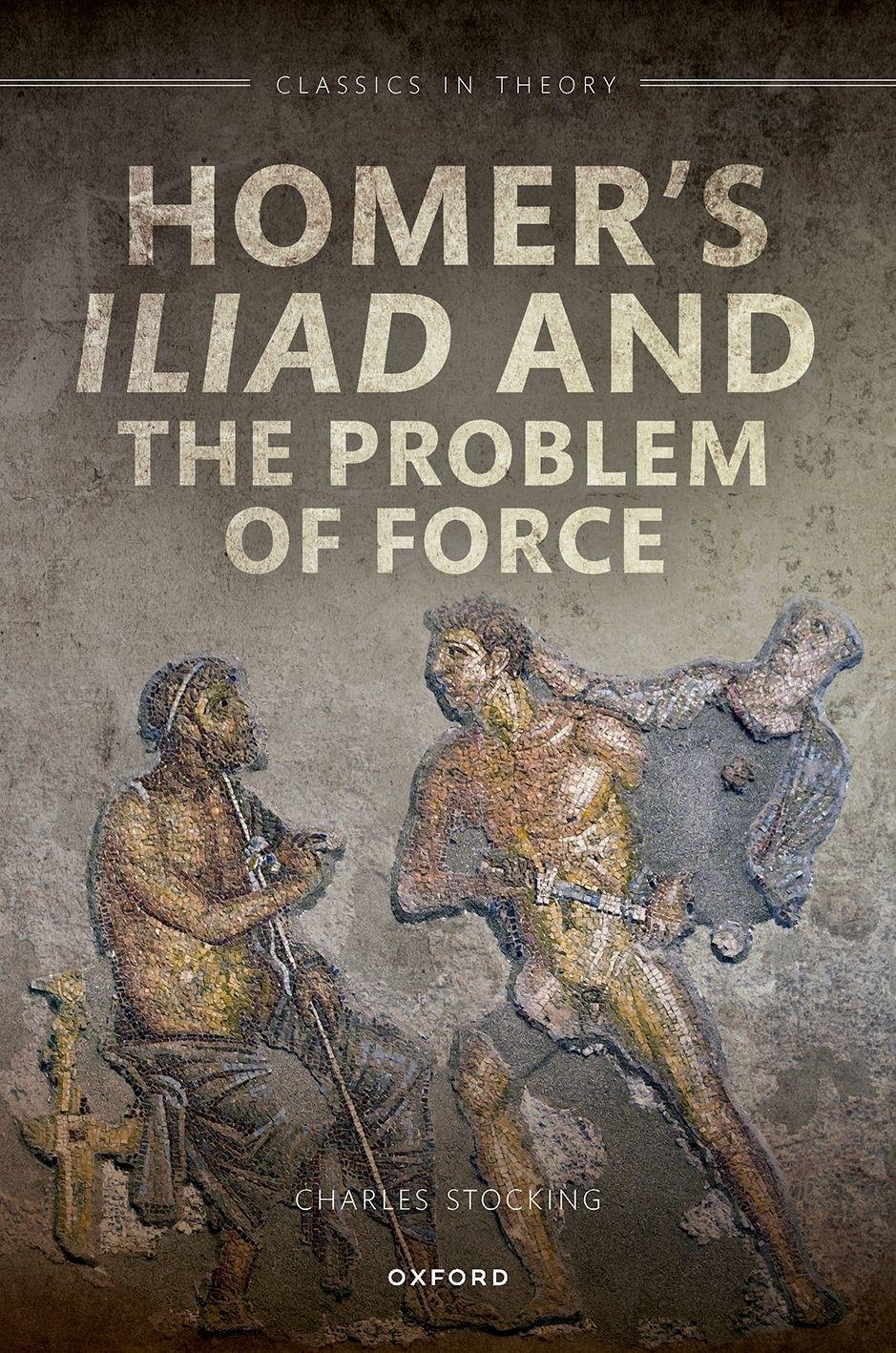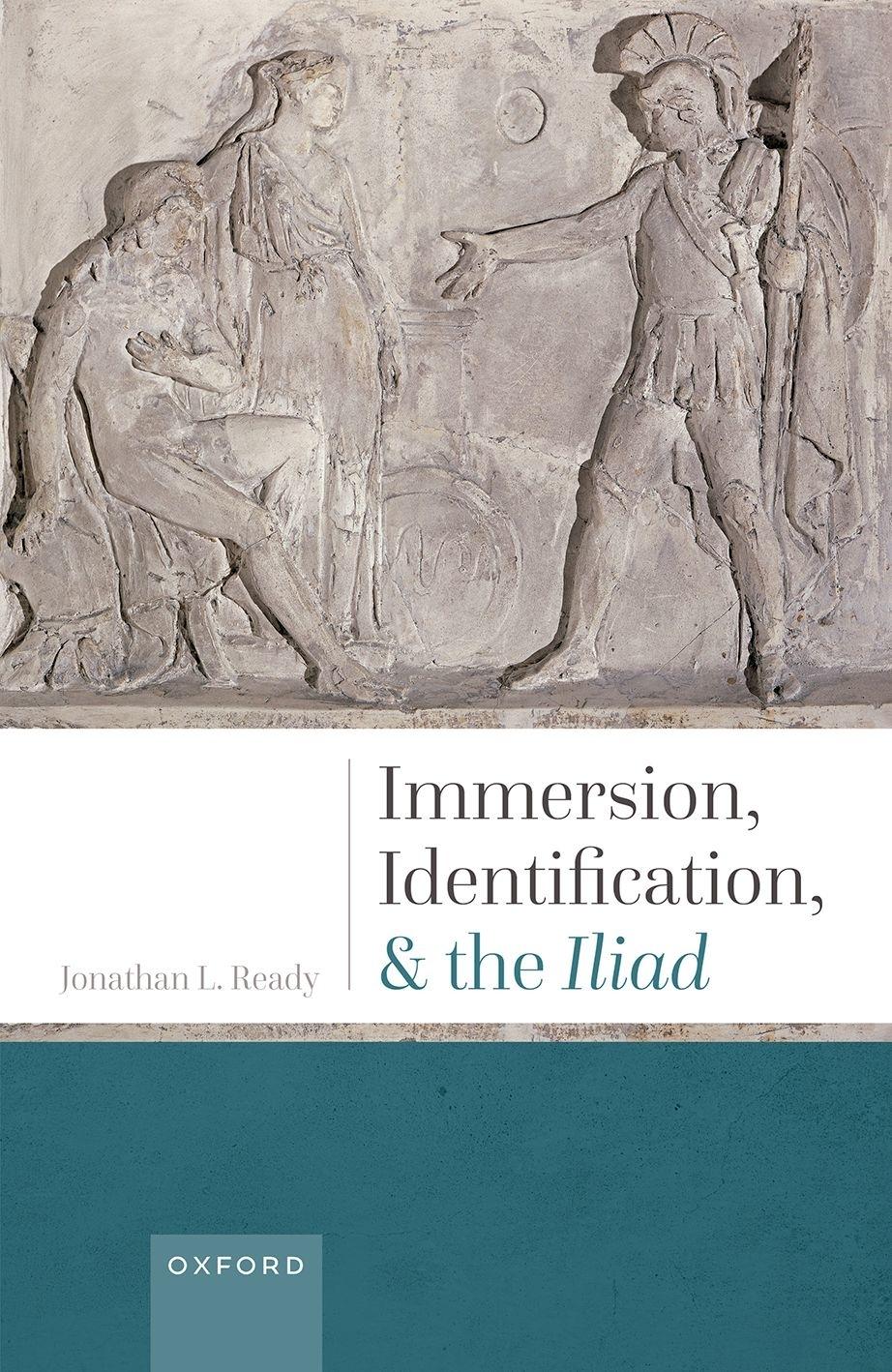1 Introduction
1.1. Overview
Section 1.2 offers definitions of narrative, storyworld, immersion, identification, and recipient. Section 1.3 orients this investigation of Homeric immersion and identification in relation to prior scholarship in Homeric studies. Section 1.4 provides a brief outline of the following chapters.
1.2. Terminology
I start with some fraught definitions. We will be talking about narrative, a tricky term to define and one that we perhaps want to be careful not to define too narrowly (Ryan 2007). Jonas Grethlein posits that a narrative is “the representation of a temporal sequence involving human or human-like characters in a sequential medium” (2017a: 34; cf. Grethlein, Huitink, and Tagliabue 2020: 8). John Frow goes into a bit more detail, discerning three essential components of a narrative (2018: 106):
a medium of representation ; a speaking voice, or some corresponding enunciative moment (the composite gaze through which we view a film, for example), which activates that medium; and the movement of persons, or
quasi-persons, through space and time and relationships in a represented world.
But there are other ways to think about the term. Fritz Breithaupt proposes that a narrative is an account that audiences understand as one possible version of what happened (2011, esp. 109, 120).
Let us move on to working definitions of storyworld, immersion, and identification. We have general agreement on a definition of storyworld: “The storyworld has two components. First, there is the setting, the place and time in which the events occur. Second, there are characters, the human or non-human agents that initiate or experience events” (Hogan 2018: 133); storyworlds are “totalities that encompass space, time, and individuated existents that undergo transformations as the result of events” (Ryan 2019: 63). Immersed recipients get wrapped up in a narrative and the storyworld it depicts and lose track to some degree of their real-world surroundings. Identification occurs when recipients interpret the storyworld from a character’s perspective, feel a character’s emotions or at least emotions congruent with those of the character, and/or root for a character to succeed. I will go into the components of immersion and identification in much greater detail over the course of this book.
Adopting these three definitions and utilizing these three concepts is already to make choices, to take a stand, and to maneuver carefully between opposed scholarly positions. For instance, MarieLaure Ryan aims to rebut Richard Walsh’s assertions (2017) that the concepts of world and immersion are not useful for the study of fictional narrative (2018: 236–7). Note too that media scholars have applied the term “immersion” to a range of phenomena and experiences (Nilsson, Nordahl, and Serafin 2016) or that many prefer a different word entirely, speaking of absorption, aesthetic illusion, enchantment, engagement, engrossment, entanglement, involvement, or transportation. Or, as a final example, observe the hedge in my formulation “the character’s emotions or at least emotions congruent with those of the character,” a response to a
dispute over the nature of our emotional engagement with characters (see section 2.5, pp. 49–50).
Less fraught but worth explicit consideration is the following. Recipients respond differently to fictional and nonfictional narratives (e.g., Vaage 2016: 26–34), but whether a narrative is fiction or nonfiction is irrelevant when it comes to these three concepts. Whereas much of the literature on storyworlds, immersion, and identification pertains to fictional narrative, it is also true that we can speak of nonfiction storyworlds, be immersed in nonfiction storyworlds, and identify with the characters in nonfiction storyworlds.1 I make this point because I want to forestall an objection to my use of these concepts by those who think that Homeric poetry is not fiction (see section 2.4, p. 34). The debate over the fictional or nonfictional status of Homeric epic does not affect this project (cf. Scodel 2021: 56–7).
Finally, I highlight here at the start how the word “recipient” that I have already used several times contributes to the presentation. It helps one avoid the cumbersome phrase “hearer, viewer, or reader,” but, more important, its capaciousness signals my concern with features of immersion and identification that do not depend on a specific medium. No doubt the nature of immersion and identification vary depending on media (e.g., Grethlein 2017a), but I target components of those experiences that arise whether one is watching, reading, or listening to a tale (e.g., Carpenter, Green, and Fitzgerald 2018: 231; cf. Budelmann 2000: 15–16; Lovatt 2013: 21). Only in Chapter 9 do I ponder how listening to and watching an oral performer of Homeric epic shaped the audience’s experience of the storyworld.
1.3. Previous Scholarship
A 1947 article in ClassicalJournalconcludes with a chart purporting to show how the audience experiences varying degrees of emotional
intensity over the course of the Iliad(Ingalls 1947). The majority of Homeric scholarship in the second half of the twentieth century had concerns other than thinking about the affective dynamics of the presentation. With attention directed to how and when the Iliadand the Odyssey were composed, energy went into determining how best to interpret them in light of those compositional mechanisms (cf. Hutchinson 2017: 145). Even those who did not worry so much about the genesis of the poems saw their job as asking after the meaning(s) or argument(s) of the poems (e.g., Redfield 1975: ix).
Occasionally, explorations of what critics termed “pathos” appeared—some longer (e.g., M. Scott 1974; Griffin 1980, esp. 104–5), some shorter (e.g., Glenn 1971: 170; Martin Mueller 2009 [1985]: e.g., 55; Davies 2002: 29). Suspense received a fair amount of attention too (Rengakos 1999; cf. Liotsakis 2021: 6), and Elizabeth Minchin considered some other ways the Iliadpoet sought “to keep us involved in his tale” (1999: 64). Typically, however, scholarly protocols allowed for only brief acknowledgments of the experience of hearing or reading the Iliad and the Odyssey and of the impact the poems can have on recipients. For example, the Iliad poet’s detailed descriptions of horrific wounds suggest that “he and his audience enjoy the scene enormously,” and the variety in these descriptions “never bores us” (E. Vermeule 1979: 96–7). In moments of embedded focalization—the narrator grants access to a character’s point of view even though the character is not talking —“the audience is brought into a closer sympathy with the character, and hence into closer emotional involvement with the tale” (Edwards 1991: 4; cf. 2002: 36). An investigation of Trojan politics starts from the observation that the poet wants audiences to sympathize with the Trojans (Sale 1994: 7–13). When the Odyssey poet “transforms folklore and anecdote,” he produces “situations of profound human meaning that lead us back to the poem again and again” (Segal 1994: 194). Achilles undergoes “an evolution in his character which is brilliantly conceived, intuitively plausible, and profoundly tragic” (Most 2003: 75). James Redfield relegates personal reflections to the preface of his book on Hector (1975: ix, xii):
The present book thus grew out of an interest in, and even perhaps an identification with, one hero . I developed the analysis because I care about the Iliad . We carry with us in our solitude these fictions the poets have left us, we brood over their meanings, feel joy and sorrow at the events, make of the characters our friends and enemies, and find ourselves somehow nourished by the experience.
Conversely, Nancy Felson saves for the penultimate page of her book on the Odysseythe following comment: “I conclude by depicting the events that occur when I as a reader envision the action of the poem…. I am lulled to silent awe and complacent satisfaction that the characters who have become my companions have finally reached home…. A provisional satisfaction overcomes me…” (1994: 143, emphasis in original). The final sentence of Leonard Muellner’s 1996 book on the meaning of mēnis also stands apart in tenor and point from what comes before: “Achilles bequeaths to us the selfperpetuating artistic representation of an idealistic, disturbing, and consoling definition of the human condition” (175).
Aristotle’s attention in his Poetics to pity, fear, and catharsis as essential components of the audience’s reaction to Greek tragedy created a permission structure for twentieth-century scholarship in that subfield to attend to the audience’s affective engagement, discussions that point up by way of contrast the general occlusion of such matters in Homeric studies.2 But Homeric studies had good company: wittingly or not, it joined other branches of literary studies in limiting, even suppressing, if not exiling, discussions of how readers respond, especially emotionally, to and become immersed in narratives.3
Fittingly, then, we were told that to consider audience response to the Homeric epics properly one should ask after the “assumptions and responses which the works themselves seem to expect” as opposed to “the assumptions and responses which we, as contemporary readers, tend to provide” (Gill 1990: 8). Our own reactions are to be segregated and then (presumably) ignored. Or one could recognize that the characters prompt “our sympathetic interest” (Gill 2002: 97), our “sympathetic engagement” (99), and
“our sympathetic involvement” (105), but this connection arises as a result of (“is a reflection of” (105), “inheres in” (152)) the careful and rigorous intellectual analysis that they compel us to perform: we become “engaged in their reasoning” (117; cf. 105, 152, 172–3) as they wrestle with “certain fundamental issues of human life” (119) and “with the questions or ‘problems’ which the poem as a whole explores” (97; cf. 173). A clinical, rational engagement is allowed. Those more willing to explore how the epics generate a range of affective dynamics often viewed such dynamics with suspicion. Consider Lillian Doherty’s assessment of the end of the Odyssey: “I have not stopped taking pleasure in the reunion of Odysseus and Penelope; rather, my pleasure has become infused with an awareness that it invites me to be reconciled to an androcentric view of the world, a view in which Penelope’s happiness is subordinate to and indeed defined by that of Odysseus” (1995: 40; cf. 192).
In keeping with broader trends inside and outside of classical studies,4 priorities have shifted in the subfield of Homeric studies. Jon Hesk asks us to confront “the difficult issue of the audience’s pleasure” and how the Iliad “deliver[s] prurient thrills and entertaining forms of terror” (2013: 33; cf. 43). Lynn Kozak’s ExperiencingHektorexplores how and why “the Iliadhas caught me with its Hektor” (2017: 1)—that is, how and why the poem enables audience members to connect with and care about its characters and engage with the tale more generally. Kozak attends to a number of factors that bring “pleasure” to recipients, from a challenge to their expectations (119), to a resolution of a storyline (121), to a “callback” (cross-reference) to an earlier episode (130), to their recognizing the typical pattern of a battle scene (137). Kozak introduces to Homeric studies the notion of “allegiance” wherein recipients judge the characters and experience like or dislike as a result (5–6, 8; cf. section 7.3, p. 211). This experience is one manifestation of our “engagement” with the characters (62, 111, 157; cf. 22). They also deploy the notion of “melodramatic alignment structure” wherein recipients “know more than any one character knows” (6; cf., e.g., Rengakos 1999: 323 on dramatic irony). This
knowledge “increases emotional investment and anticipation of the events to come” (Kozak 2017: 92; cf. 100, 137–8, 140–1, 151, 170, 198). And Kozak traces still other ways in which the poem builds anticipation, suspense, curiosity, and even anxiety in its audience (8–9, 27, 29, 31, 82, 95, 102, 115, 143, 147, 195, 218). Focusing on the Iliad’s divine apparatus, Tobias Myers queries “the emotional impact [on the audience] of the devastation at Troy,” “the intensity of their [the audience members] experience as they listen to the telling,” and how “the poet understands himself to be hooking his listeners” (2019: 3, 33, 175). He writes, “While the Iliadresponds wonderfully to analysis, it is aimed not at analytical critics but at audiences ready to be swept away by wonder, pleasure, terror, and tears” (59; cf. 91, 93). At the same time, Myers argues, the Iliad poet urges his audience to consider their emotional reactions to the tale (124, 210).
Rachel Lesser discerns a triad of desires felt by the Iliad’s audience (2022, esp. 12–22). They experience narrative desire (wanting to learn how the story will turn out), sympathetic desire (feeling for a character and hoping all goes well for them), and empathetic desire (taking on a character’s “urges, wishes, and longings” (18)). The audience can sympathize and empathize with a range of characters —Chryses, Achilles, Hera, Helen, Menelaus, Agamemnon, Odysseus, Andromache, Patroclus, Priam, Hecuba; they can sympathize and empathize with a specific character at one moment but not at another (178, 189, 213, 228). Sympathetic and empathetic desires can go hand in hand with and even enhance narrative desire (21, 30, 107, 189, 195, 200, 203, 215, 221, 229, 241), or they can conflict with it, causing at times feelings of dissonance or even dread (99, 128, 153, 178, 181, 199, 215). Liberating too is Joel Christensen’s study of the therapeutic work afforded (or not) by storytelling to the characters and external audiences of the Odyssey (2020; cf. Grethlein 2017b: 118, 271–82). Homerists, then, have answered Gregory Hutchinson’s call for “thinking more about how the poem affected listeners” (2017: 168).
This book builds on these interventions as well as on additional scholarship by investigators of the ancient world—both in Greek
studies and Roman studies and in biblical studies—that starts from two facts now well-established in disciplines outside classical studies devoted to the exploration of narrative. When people read a story or when they watch a play, movie, or television show, many find themselves immersed in the tale and its world and many identify with the characters (cf. de Bakker, van der Berg, and Klooster 2022: 15–17). More than that, many consume media in order to immerse themselves in the tale and its world and to identify with the characters: they “choose” and “allow” themselves these experiences (Plantinga 2018: 195, 249) and “strive to be overcome by the objects of their passion” (Felski 2020b: 65). We can shift priorities and think about narratives as more than a series of puzzles for the critic to solve.
One can find these propositions in traditional sites of literary criticism. From her perch in English, for example, Rita Felski points to the necessity of taking seriously the majority of readers who read in an apparently “unseemly or inappropriate fashion—identifying with characters, becoming absorbed in narratives, being struck by moments of recognition” (2015: 29; cf. 191; 2008: 14, 17–18; 2020b: 25; Moi 2019: 59). We critics, she writes, should overcome our fear “of being contaminated and animated by the words we encounter” (2015: 12), and whereas our training prompts us to ask colleagues, “‘But what about power?’,” we should now ask, “‘But what about love?’ Or: ‘Where is your theory of attachment?’” (17–18). Drawing especially on Bruno Latour’s actor-network theory to argue that texts “make things happen” (168, 180; cf. 2020b: 21–4), Felski proposes a “postcritical reading.” This approach “treat[s] experiences of engagement, wonder, or absorption not as signs of naïveté or user error but as clues to why we are drawn to art in the first place” (2015: 180). It asks, “How do works of art move us, and why? Are certain features of texts more likely to trigger empathy or recognition, absorption or disorientation? What does it mean to talk about identifying with a character?” (181; cf. Anker and Felski 2017; Felski 2020a).
Felski’s clear articulations of the matter at hand and of its stakes inspire (cf. Docherty 2021), but I concentrate for the most part on other research in communications, literary studies, media studies, and psychology that provides accessible and precise definitions and models of immersion and identification as well as actionable findings on how immersion and identification come about. This project represents the first book-length application of that research to the Iliad. It thereby helps explain why people care about this epic poem and its characters (cf. B. Vermeule 2010) and how they actually respond to the poem. Put differently, those of us in Homeric studies who want to think about narrative immersion and identification should take as our guides researchers in those aforementioned fields who study narrative immersion and identification and especially those researchers who do so in an empirical fashion. By empirical, one refers to controlled experiments with results subject to falsification (Hakemulder and van Peer 2016: 192; differently, Margolin 2008: 9).
To be sure, several relevant contributions in classical studies that address issues of immersion and/or identification do not choose this route. Studying “images of song” found within the Homeric epics, Stephen Halliwell notes the poems’ concern with an audience’s “intense absorption,” “rapt concentration and engagement,” and “total immersion” (2011: 45; cf. Liebert 2017: 48–62; Ready 2018: 170–84; Giordano 2022: 177–83). In an earlier intervention, Halliwell addresses Plato’s Republic: performers experience “self-likening, absorption, and identification” and “full psychological immersion” with characters (2002: 54, 79) whereas audience members experience “‘sympathy’ rather than ‘identification’” (81; cf. 93). Nancy Felson’s influential article, “Vicarious Transport: Fictive Deixis in Pindar’s PythianFour,” finds “Pindar uses deixis with expertise and subtlety, primarily to make his audiences ‘travel’ across space and time…. He transports them along carefully demarcated pathways” (1999: 5; cf. Sobak 2013: 111 n. 10, 115 n. 21; Weiss 2016: 250; Neer and Kurke 2019: 37, 204, 276). Pauline LeVen queries how Timotheus’s Persians“immerses its audience” such that it “is brought
to the scene” (2014: 201–2) and experiences “mental transport” or “mental displacement” (217–18; cf. 242). A deictic shift (see section 6.3, p. 188) enacted by the use of the imperfect tense contributes to this effect (197–204). What is more, intertextual citations in the direct speech of characters endow the characters with “fictional weight” (216) and make them into entities “whom the audience can not only observe directly but also project into, in [a] form of wishfulfillment fantasy” (209; cf. 232). Jonas Grethlein argues that ancient prose writers—Thucydides in his History of the Peloponnesian War, Xenophon in his Anabasis, Plutarch in his Alexander, Tacitus in his Annals, Polybius in his Histories, and Sallust in his The War with Catiline—deploy a range of techniques that make us feel as if we experience the narrated events or as if figures from the past come before us (2013). The use of the imperfect tense and the historical present “let the reader follow the battle as if it was unfolding right before her eyes” (34; cf. 63). Internal focalization renders the action “present” (34), gives the recipient “a sense of witnessing history as it unfolds” (36), and “puts the reader right on the spot of the action” (56; see section 6.3, pp. 182–7). Speeches by characters suggest “unmediated access to the past” (36) and “contribute to making the past of the narrative present” (64; cf. section 6.3, p. 190). Techniques for creating suspense (see section 7.2) help us feel what “the historical agents must have felt” (44). “Sideshadowing” raises the specter of something happening that does not ultimately transpire, and these potentialities put us in the shoes of the characters who do not know what the future holds (14, 45, 69). When a recipient fills in “blanks” about what happened to a character, this act of supplementing “deepens the immersion of the reader” (88). Second-person address to the implied reader “deepens the immersive quality” of a passage (99; see section 6.3, p. 187). A “spatial deixis” that tracks the movement of a character can make “the scene highly graphic” (122). Highlighting ambiguities and uncertainties regarding cause and effect and the course of events recreates for the recipient what it felt like to live through the narrated period (154–6, 165–7). Recipients can feel themselves addressed when a character addresses in the imperative mood an
internal audience: “the blending together of internal and external audiences raises the immediacy of the narrative” (260–1). A conclusion that resists closure “binds the reader into the world of the narrative” (303).
We can approach the topics of immersion and identification in various ways. Nevertheless, I take my inspiration from: Michael Power’s 2006 doctoral dissertation, TransportationandHomericEpic, which employs Richard Gerrig’s model of transportation (1993) and Melanie Green and Timothy Brock’s expansions of that model (2000; 2002) to explore how recipients respond to Odyssey 9 and, more precisely, to the “ambiguous” characterization of Polyphemus and Odysseus; from Rutger Allan, Irene de Jong, and Casper de Jonge’s 2017 article on the Homeric epics, “From Enargeia to Immersion: The Ancient Roots of a Modern Concept,” which looks to Ryan’s 2001 book, Narrative as Virtual Reality: Immersion and Interactivity in Literature and Electronic Media (cf. Clercx 2018); and from five pieces by Rutger Allan that deploy a range of research on immersion from outside classical studies—the work of Ryan features as does that of Green and Brock, of Kaitlin Fitzgerald and Green (2017), of Anneke de Graaf et al. (2012), and of Werner Wolf (e.g., 2013)—to explore immersion (and identification, to a lesser extent) in ancient texts, including the Homeric epics: “Construal and Immersion: A Cognitive Linguistic Approach to Homeric Immersivity” (2019a); “Herodotus and Thucydides: Distance and Immersion” (2019b); “Narrative and Immersion: Some Linguistic and Narratological Aspects” (2020), which studies some passages in the Iliad and in Thucydides’s History of the Peloponnesian War; “Metaleptic Apostrophe in Homer: Emotion and Immersion” (2022a); and “Persuasion by Immersion: The narratioof Lysias 1, OntheKillingof Eratosthenes” (2022b).
I also tip my hat to Jonas Grethlein and Luuk Huitink’s article, “Homer’s Vividness: An Enactive Approach.” To get at how Homeric epic “transports listeners and readers,” “captivates the audience,” and casts its “spell…on listeners” (2017: 83–4), they leave the friendly confines of classical studies and utilize an enactive approach
from cognitive (literary) studies (or more properly an approach from the branch of enactivism called “sensorimotor enactivism” (Ward, Silverman, and Villalobos 2017: 370–2)). In his 2021 book, Grethlein uses the same tools to illuminate the immersive potential of the paedagogus’s false report of Orestes’s death in Sophocles’s Electra (2021a: 53–67). Finally, I single out two monographs in biblical studies. Eric Douglass’s Interpreting New Testament Narratives: RecoveringtheAuthor’s Voice(2018) constructs an idiosyncratic but detailed model of identification that overlaps in several of its particulars with the empirical studies of identification I will use. Douglass cites publications by Keith Oatley (1994) and Jonathan Cohen (2001), two scholars whose extensive bibliographies feature prominently in my own presentation. In Identifikationspotenziale in den Psalmen: Emotionen, Metaphern und Textdynamik in den Psalmen30, 64, 90 und 147 (2019), Sigrid Eder also interacts with early formulations of Werner Wolf (1993) and Oatley (1994) and makes use of research from still other scholars whose work will appear in what follows, such as Ed Tan (1994), David Miall and Don Kuiken (2002), and Suzanne Keen (2007).
I would urge sticking to the work of researchers in narrative studies. In a chapter that culminates in an analysis of Hermes’s arrival on Ogygia in Odyssey 5 (2019a), R. Allan turns to Rolf Zwaan’s “Immersed Experiencer Framework” (2003; cf. Grethlein 2021a: 102; 2021b: 226–7). As Allan stresses, Zwaan aims to explain how we comprehend language: he does not aim to explain narrative immersion (2019a: 66). This feature of Zwaan’s model presumably justifies its application to the study of narrative: if language comprehension is a matter of immersion and we are studying immersion in narratives that involve language comprehension, then we should be looking at research on language comprehension as immersive. I grant that the study of literary texts benefits from the application of embodied theories, such as Zwaan’s, of how one processes language. In this case, however, I worry that if we focus on how linguistic activity writ large involves immersion, we lose sight of what is distinctive about recipients’ immersion in
narratives: as Wolf opines—using aesthetic illusion, his preferred term for what others call immersion—“there is a special relationship between aesthetic illusion and narrative” (2014: section 3.4). To wit, the immersed reader understands that the storyworld is not the real world; this “bifurcation” (Felski 2008: 74) or “twofoldness” (Plantinga 2018: 31) does not concern Zwaan’s immersed experiencer.
This attribute of immersion in narratives has important implications. For example, one can speak of temporal immersion. Temporally immersed recipients attend to a character’s past, present, and future: they focus on the relationships between events in the character’s past to their present circumstances and between events in their present to possible outcomes in the future (Ryan 2015a: 99–106). In keeping with the idea that narrative offers a safe space for emotional (Oatley 2012: 51, 140; Menninghaus et al. 2017; cf. Oatley and Gholamain 1997: 267) and empathetic (Keen 2006: 220; Caracciolo 2016: 42–3, 45; Lesser 2022: 20) engagement—an idea ventured by Plato (Republic 605c9–606c9; Halliwell 2005: 400) and discernable in eighteenth-century writers too (Gallagher 2006: 351) —Grethlein reflects on the attraction of temporal immersion (2017a: 52–3; cf. 56):
They [readers] confront time in the same way as in the everyday world, however, without any pragmatic strains. As in their own lives, readers have re- and protentions and harbour expectations as well as memories. Yet, the memory of what has happened is without the weight it has in real life, the anticipation of what will come without the anxiety of everyday expectations. Narrative permits us to undergo an experience without being directly affected by it. It allows us to experience the force of time and simultaneously keeps it at a safe distance . Narrative subjects us to, and simultaneously lets us overcome, the force to which we are exposed in the everyday world . Readers experience time but free from its real-life implications, notably death.
Temporal immersion brings these benefits. That recipients are not actually in the storyworld and know that they are not enables them to profit from the experience of temporal immersion.
1.4. Outline of Chapters
This book contains two parts. Part I addresses identification. I start with identification because identification goes hand in hand with immersion and because the discussion of immersion in Part II at a couple of points builds explicitly on the findings in Part I. This first part comprises Chapters 2 through 4.
The first lengthy section of Chapter 2, section 2.2, uses the aforementioned 2017 article by Allan, de Jong, and de Jonge to begin exploring the components of identification with characters in a narrative. It directs attention to the capacious but granular models of identification crafted by researchers outside of classical studies. Section 2.3 delves deeper into the factors those researchers see operating as triggers for identification, such as the degree to which recipients find characters similar to themselves and the degree to which they deem the narrative realistic. Invoking ancient writers and commentators from Gorgias to Aristarchus, section 2.4 investigates the numerous precedents we find in ancient scholarship for a study of identification. Section 2.5 explains why I am comfortable with the terms “character” and “emotion,” why I speak of modern recipients experiencing “emotional identification” with Homeric characters, and what I mean by emotional identification.
Chapter 3 initiates our study of the Iliadand lays the groundwork for the close readings presented in Chapter 4. Section 3.2 reviews nine features of the poem as a whole that prompt identification with its characters, from the prevalence of laudatory epithets to the abundance of well-known characters. Section 3.3 examines how Homeric characters enable their interlocutors to identify with the characters in the stories they tell: this move on the characters’ part reflects the poet’s own efforts to encourage the external audience to identify with his characters.
Chapter 4 studies first identification with mortal characters in four discrete episodes in the Iliad (4.2) and then identification with divinities in the Homeric Hymn to Demeter (4.3.1) and in two episodes in the Iliad(4.3.2 and 4.3.3). These detailed analyses bring
out the various ways in which the Iliad cues identification with its cast of characters. Section 4.4 considers factors that interrupt the experience of identification or even impede a recipient’s ability to identify with a character. These breaks and obstacles allow the recipient to recharge for another round of identification, a taxing endeavor. Section 4.5 rounds off the chapter and Part I by querying the politics of identification: it critiques identification’s critics and defenders and asks what recipients get out of the experience.
Part II on immersion comprises Chapters 5 through 8. Chapter 5 provides a point of entry into the subject. Section 5.2 charts how ancient authors and critics, from Hesiod to Longinus, talked about what we call immersion. Section 5.3 offers an introduction to research on immersion in fields outside classical studies, stressing how investigators tease out the distinct components of the phenomenon.
Chapter 6 begins by exploring spatial immersion: the investigation looks at the Iliad’s settings, the poem’s moveable objects and people, and how it handles switches in location (6.2). This section concludes with an exploration of how the poem’s numerous place names help establish the storyworld. Section 6.3 examines spatiotemporal immersion. It tackles the motor resonance triggered in recipients by descriptions of characters’ actions and descriptions of the actions of the objects the characters use; moments of internal (embedded) focalization; inclusive forms of address (such as “you”); similes; and different forms of speech presentation, including speech introductions.
Chapter 7 considers emotional immersion. Section 7.2 investigates suspense. It lays out the relevance of different kinds of suspense (how-, when-, what-) to the Iliad and then asks what makes those of us with prior knowledge of what will happen feel suspense, pointing to our attachment to characters. The section continues with a discussion of diegetic versus non-diegetic delay as mechanisms of suspense and considers similes from that angle. It closes with a brief comment on so-called metasuspense, wherein a recipient wonders how the teller will keep the story on its proper course. Section 7.3
studies first how the Iliad prompts us to feel a range of other emotions by triggering our propensity to judge people (and characters) and second how the poem can get us to feel emotions for ourselves, “not for others” (Ryan 2015a: 108), such as disgust.
Chapter 8 attends to matters of content and form. On the one hand, the Iliad immerses us by taking us into the inner lives of its characters (8.2). On the other hand, the Iliadimmerses us because it prompts us to think about ourselves and brings to mind personal memories; recipients’ familiarity with the poet’s compositional mechanisms also aids immersion (8.3). Indeed, immersion can arise not only when we are enmeshed in the Iliad’s storyworld but also when we attend to the formal features of the poetry (8.4).
The concluding Chapter 9 begins with caveats and speculation. A narrative neither continually immerses recipients nor continually demands that they identify with the characters, and recipients’ own traits and attributes influence their degree of immersion and identification. We can make informed guesses about how the Homeric poet’s oral performance affected recipients’ experience of immersion and identification. About other components of these experiences we can be more confident. Immersed recipients tend not to find fault with the text (counterargue), and immersion and identification have the ability to inform one’s ideas and even actions after the reading or viewing experience ends. I reflect on how these factors shape(d) responses to the Iliadand then conclude by urging teachers of the Iliad to discuss immersion and identification with their students.
People have been listening to and reading the Iliadfor over 2,500 years. What exactly enables such persistence requires attention (cf. Dimock 1997; Felski 2008: 10–11, 115; 2015: 154–5, 169). The power of the institutions under whose auspices recipients tend to encounter the Iliad—from the Panathenaic festival in ancient Athens to departmental curricula in modern universities—and the inertia of those institutions can only account for so much. Nor am I fond of the idea that the Iliad contains a set of timeless lessons that every generation needs to learn. Rather, the Iliad’s ability to immerse its
recipients and prompt their identification with its characters provides a better explanation of its durability.
With that durability in mind, I sometimes try to reconstruct a notional archaic-era audience member’s reaction to the Homeric text and I sometimes posit a transtemporal reaction. I toggle back and forth between these endeavors (cf. Budelmann 2000: e.g., 7, 64, 157; Griffith 2015: 27, 48 n. 113). There is equal value in considering how the Iliad resonates with ancient and modern audiences.
Immersion, Identification, and the Iliad. Jonathan L. Ready, Oxford University Press. © Jonathan L. Ready 2023. DOI: 10.1093/oso/9780192870971.003.0001
1 Chen, Bell, and Taylor 2016; 2017; Fitzgerald and Green 2017: 56; Roberts 2018; R. Allan 2019b; 2020; Ryan 2019: 62–3, 66; Alam and So 2020; FernandezQuintanilla 2020; Maloney 2020; Tyrell 2020: 48; Grethlein 2021a: 49, 55–6, 264; Goffin and Friend 2022: 135.
2 E.g., Stanford 1983; Heath 1987; Griffin 1998: 54–61; 1999: 91–2; Griffith 1999b: e.g., 43; Budelmann 2000: e.g., 23, 91; cf. Wohl 2015: 12, 168 n. 6.
3 M. Smith 1995: 188–9; Robinson 2005: 143; Davis 2007: 20; Felski 2008: 54; 2015: 12–13, 54; 2020b: 30, 62; Ryan 2015a: 107; Grethlein 2017a: 4, 123; 2021a: 154; 2021b: 228; Douglass 2018: 112; Hogan 2018: 4; Plantinga 2018: 211; Kuzmičová and Bálint 2019: 430; Knox 2021: 12; cf. Sedgwick 2003: 144, 150.
4 Inside: e.g., Wohl 2015: 28, 106–9, 135–6; Cairns and Nelis 2017: 10–11; Olsen 2017; Meineck 2018; Weiss 2020: 333; de Bakker, van der Berg, and Klooster 2022: 10–15. Outside: e.g., Robinson 2005; Plantinga 2009; Hogan 2018; Grethlein 2021a: 103.

